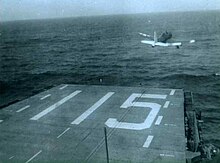Ryan FR
| Ryan FR Fireball | |
|---|---|
 Ryan FR-1 of the National Advisory Committee for Aeronautics |
|
| Type: | Fighter plane |
| Design country: | |
| Manufacturer: |
Ryan Aeronautical Corporation |
| First flight: |
June 25, 1944 |
| Commissioning: |
1945 |
| Production time: |
1944 to 1945 |
| Number of pieces: |
66 (+ 3 prototypes) |
The Ryan FR Fireball was an American combined piston and jet propulsion fighter designed towards the end of the Second World War . The FR-1 was the US Navy’s first jet aircraft , but was no longer used in combat during the war.
history
development
Development began in December 1942 with an application from Admiral John S. McCain Sr. for a hybrid propulsion fighter . From a total of nine applicants, Ryan received the development contract on February 11, 1943. The very tight schedule envisaged the delivery of the first cell for static tests after one month and the flight of the first of three prototypes after 14 months.
The early jet engines produced poor acceleration and were still considered unsafe. They also seemed unsuitable for landings and take-offs on aircraft carriers . The mixed propulsion allowed conventional flights and the additional jet engine should generate a high top speed.
The prototype XFR-1 flew on June 25, 1944, however, still without jet propulsion. This machine was lost in a crash in October of that year. After the crashes of the second and third prototypes on March 25, 1945 and October 10, 1945, the cause was suspected to be insufficient riveting of the wings. The rivets' countersunk holes were cut open through them. Until the remedy by doubling the number of rivets in the outer wing area, the flight load was limited to 5 g instead of the 7.5 g previously approved .
Planned further development
For a variant FR-2 , the first step in further development was to replace the R-1820-74W radial engine with a more powerful engine. The FR-3 would have been created by replacing the I-20 jet engine (J31). 600 copies of the FR-2 were ordered on January 31, 1945, but both projects were canceled on VJ-Day .
From the FR-1 Fireball, the XF2R-1 with turboprop propulsion was developed, of which only a prototype was built. The prototype reached 805 km / h on test flights.
commitment
In the end 700 machines were ordered, of which only 66 machines were delivered from March 1945 until the surrender of Japan . Until the end of the war, only the VF-66 fighter squadron was deployed, but was no longer used. Only three aircraft were tested on the aircraft carrier USS Ranger (CV-4) before the squadron was decommissioned on October 18, 1945. The personnel and the aircraft were transferred to the VF-41 (later VF-1E) squadron. In November 1945, the Fireball was the first American jet aircraft to land on an aircraft carrier, the escort aircraft carrier USS Wake Island (CVE-65) . In March 1946, further tests took place on the escort aircraft carrier USS Bairoko (CVE-115) and from March to June 1947 on the USS Badoeng Strait (CVE-116) . Soon after, the FR-1 was retired because the airframe was structurally too weak for use on aircraft carriers and the rapid advances in jet engines made the mixed propulsion unnecessary.
The US Navy pilots thought the name "Fireball" was badly chosen because there had been some "burning" machine crashes.
Remaining / preserved machines
Only one specimen has survived, the FR-1 with the BuNo 39657. Originally used at the NASA Ames Research Center, it was then used for training purposes at the Lewis Institute in Illinois, a technical school, before being transferred to the Planes of Fame Air Museum in the 1960s in Chino, California. It was restored here and has been open to visitors since June 13, 2009.
Technical specifications
| Parameter | Data |
|---|---|
| Length: | 9.86 m |
| Wingspan: | 12.19 m |
| Wing area: | 25.55 m² |
| Height: | 4.15 m |
| Piston drive: | a radial engine Wright R-1820 -72W Cyclone with 1,060 kW (1,425 PS) |
| Jet propulsion: | a General Electric J31 with 7.1 kN |
| Top speed: | 686 km / h |
| Range: | 2,100 km |
| Crew: | a pilot |
| Service ceiling: | 13,100 m |
| Empty weight: | 3,590 kg |
| All-up weight: | 4,806 kg |
| Armament: | four 12.7 mm machine guns, two 450 kg bombs, four missiles |
variants
XFR-1
Military designation of the prototype "Model 28", 3 pieces built.
FR-1 Fireball
Single-seat fighter, 66 built.
FR-2
Converted to the Wright R-1820-74W radial engine, which replaced the piston engine, 1 machine was modified.
FR-3
Proposed version with a General Electric I-20 jet engine to replace the original jet engine; was never realized.
XFR-4
Modified variant with a Westinghouse J34 turbojet engine; built a machine.
XF2R-1 Darkshark
Conversion / further development with turboprop engine GE XT31-GE-2 and jet engine GE J-31-GE-3, one machine built.
Web links
- aviasatr.org (English)
- Jets45 (English)
- aviationtrivia.info (English)
Individual evidence
- ^ A b Bill Norton: US Experimental & Prototype Aircraft Projects - Fighters 1939–1945. Specialty Press, 2008, ISBN 978-1-58007-109-3 , p. 233.


